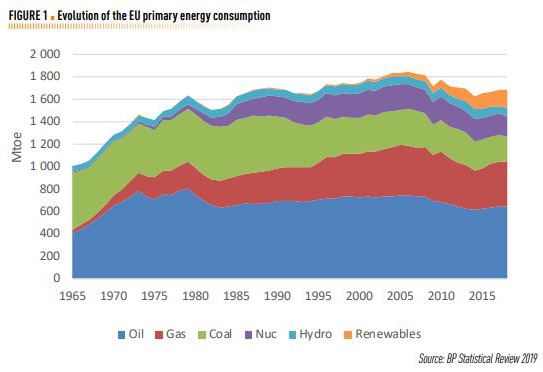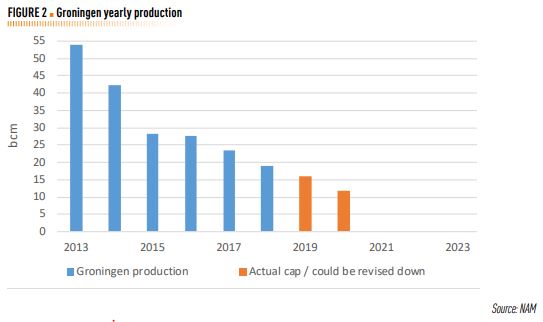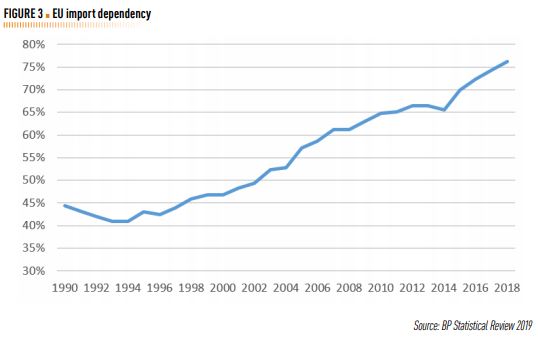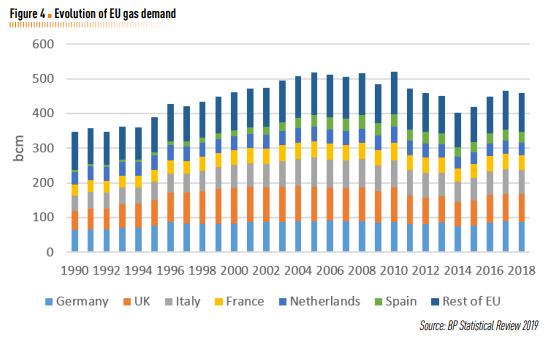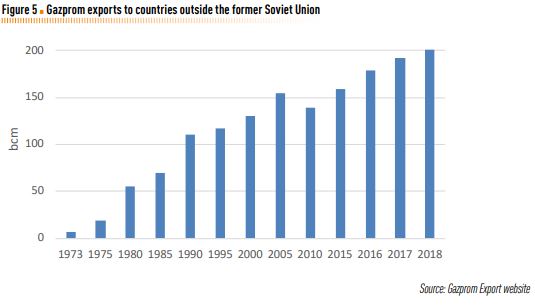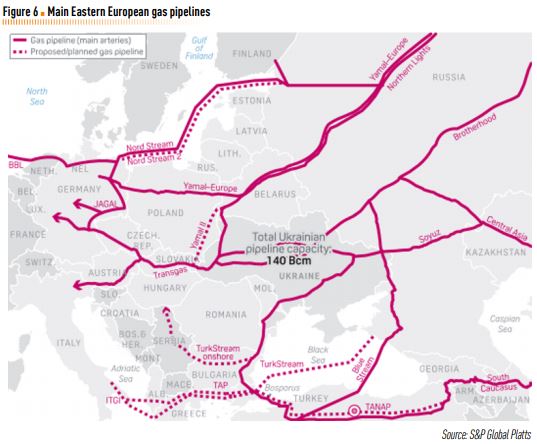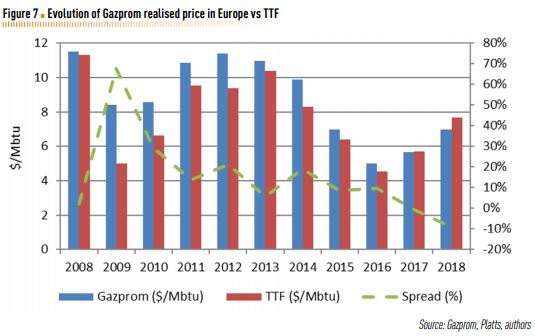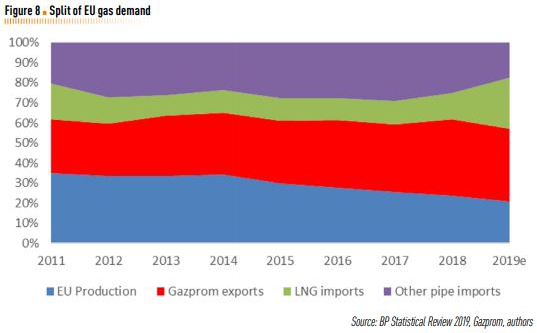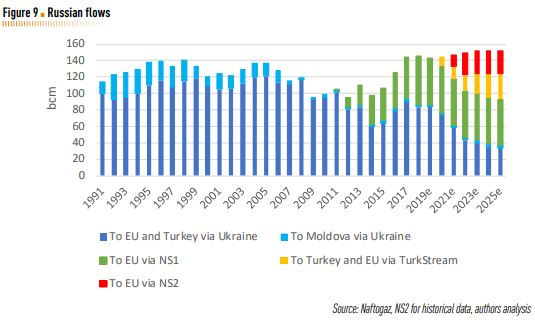Russian Gas Pipelines and the EU: Moving From a Love-Hate Relationship “With Adults in the Room”? [GGP]
For more than 20 years, in the energy area, the relationship between Russia and the European Union is too often governed by gas pipelines. They are a major tool of the diplomacy played skillfully by President Putin since his accession in 1999 to the Presidency of the Russian Federation. With his open and direct support, offshore pipelines NordStream1, SouthStream, NordStream2, TurkStream1 and 2 have been successively promoted by Gazprom to circumvent Ukraine which is still the main transit country for Russian gas today. The annexation of Crimea in 2014 followed by the western sanctions on Russia and the permanent situation of rampant war in Eastern Ukraine made the Russian pipeline projects a major source of division between the Member States of the European Union. This story tries to identify the main problems raised by the Russian projects and to examine whether and how these problems could be solved for the benefit of all the parties concerned, on a long term basis.
THE EUROPEAN GAS NEEDS
|
Advertisement: The National Gas Company of Trinidad and Tobago Limited (NGC) NGC’s HSSE strategy is reflective and supportive of the organisational vision to become a leader in the global energy business. |
Today, natural gas represents some 24% of the primary energy consumption of the European Union and is the cleanest fossil fuel supposed to stay the longest in our energy mix. In its World Energy Outlook of November 2019, the International Energy Agency (IEA) said that gas demand should decrease slowly from 2025 but would still represent about 90% of the present consumption in 2040. It is emitting less greenhouse gases than other fossil fuels especially coal and oil products. It is widely used by industry as feedstock, for power generation and for heating and cooling in buildings. It is more and more used for transport, with Compressed Natural Gas (CNG) for cars and Liquefied Natural Gas (LNG) for shipping. After a serious decline between 2010 and 2014, natural gas demand is again on the rise, thanks to the multiplication of decisions to phase out coal and nuclear in many countries, such as UK, Germany or Belgium before others to come. While ten years ago, the domestic gas production within the EU was still representing 35 to 40 % of the consumption, its decline is now accelerating with the unexpected fast closure of the main Dutch gas field in Groningen, now planned in 2022, which amounted to about 10 % of the European consumption. As a direct consequence, the needs for gas imports are growing rapidly and imports are now close to 80% of the consumption.
The main external pipe suppliers are close to the EU, with Russian Federation being the most important (35% of consumption), directly followed by Norway (22%), an Economic European Area (EEA) member, and Algeria (7%). The main carrier of this gas is offshore and onshore pipelines, linking the gas fields to the consumption centers through a meshed network outside and inside the EU. In the last ten years, LNG coming by ships loaded in many countries, among which Qatar, Nigeria, Trinidad and Tobaggo and more recently USA and Russia, to receiving LNG terminals in a growing number of EU ports is gaining ground and comes close to 15% of the EU consumption. The continuous supply of EU consumers with natural gas is seen as a matter of priority by most of the Member States, Germany being the first customer with 20% of the EU consumption.
The continuous supply of EU consumers with natural gas is seen as a matter of priority by most of the Member States, Germany being the first customer with 20% of the EU consumption.
It has also been Gazprom’s strategy to grow its volumes and market share in the EU (up to 35% in 2018) that represents the most lucrative market.
This strategy is now changing as Gazprom is investing mostly to provide gas to China where it wants to grow its market share from 0 in 2018 to 13% in 2035 to become there also the first supplier. It is not willing to continue to maintain about 100 Billions cubic meters per annum (Bcma) spare capacity that it used to in the past (spare capacity is now around 70 Bcma) and it also disclosed that its new strategy is to keep a 35%+ market share in Europe between 2018 and 2035.
In spite of the ambitious scope of the Green Deal released by the European Commission on 11 December 2019 and the recent decision of the European Investment Bank not to finance gas projects after 2022, prospects for gas demand appear very good for the next 10-15 years during which coal and nuclear will be phased out, in particular in Germany. In addition, in a context of growing electrification of the economy, increasing and cheaper variable renewables sources will probably not be able to ensure simultaneously the full substitution everywhere in the EU, without a substantial back up that gas fired power plants may provide. Industry will not be able to switch easily to other fuels than gas used as a key feedstock. And the hope for more renewable gas and green hydrogen coming on the market has still to materialize in cost effective terms. This means that EU import dependency will continue to grow whatever the demand outlook and should soon be over 80%.
PIPELINES VS LIQUEFIED NATURAL GAS
Gas pipelines are physical infrastructures built underground onshore and subsea offshore over hundreds or thousands kilometres, to transport the gas extracted from the gasfields in Siberia or the Norwegian Continental Shelf and North Seas to the consumption centers. They create a long term relationship between the producer and the consumer and their financing is to be guaranteed by long term supply contracts, consisting in take or pay fixed annual volumes with some flexibility for both parties. Up to a recent past, such contracts were concluded for 25 years or more and were subject to sophisticated prices formula usually indexed on oil price. Since 10 years and with the increase of competition between EU suppliers, due to the fast opening of the market after the third gas directive in force since 2009, the EU market has become more liquid. Prices have been more and more set at gas trading hubs such as TTF (Title Transfer Facility) in the Netherlands setting the European prices, similar to the Henry Hub setting the US prices for decades. As a result, prices become less and less linked to oil prices and are more and more set according to the offer and demand balance on a fast growing liquid market, blending gas from all sources. In addition, the flexibility offered by LNG ships demonstrates the LNG advantage on the rigidity of piped gas underpinned by long term take or pay contracts.
Traditional suppliers are now forced to adapt to the new rules of the market, the growing number of suppliers, the abundance of gas worldwide and the increased correlation of regional prices (Asian, European and US prices) to the benefit of a global gas price. Within the EU, this means that the biggest external supplier of gas, Gazprom which still enjoys the monopoly of export of Russian pipe gas, had to adapt its pricing policy to this new situation, for the welfare of the EU customers.
This liquidity has also been made possible by the development of a strongly meshed and highly flexible gas transport network, managed independently from the suppliers, and linking storages, LNG terminals and countries across borders. To ensure security of supply, and as a consequence of the Russian gas supply disruption in January 2009, EU standards have been established since 2010 by the EU regulation on security of gas supply: reverse flows mandated on all pipelines, each Member State to rely on three different sources of supply, harmonised supply standards for consumers, the N-1 infrastructure standard (to enable each country to rely on sufficient infrastructure or demand management tools to face a major supply disruption) and the implementation of solidarity in case of emergency.
WHAT IS THE PROBLEM WITH RUSSIAN GAS PIPELINES?
Russian oil and coal exports to the European Union are never attracting a lot of attention, in spite of their major significance. It is always gas exports which are raising difficulties and it is appropriate to understand why it is so.
As Russian pipeline gas delivered in Europe is the lowest cost it could easily outcompete any other non-domestic supplier. This is why after having pushed back the EU liberalisation process and the move away from Long-Term oil-indexed contract to spot market, Gazprom is now able to thrive by selling its additional gas under its own Export’s Electronic Sales Platform (ESP) as an added flexibility tool. Buyers can select either to call more contracted gas (above the 70% minimum Take or Pay) or bid on the ESP while Gazprom provides the volumes required to balance the market. This mechanism allows Gazprom to continue to push for long-term contracts (to finance the upstream capital expenditure and the booking of the transport capacity) without losing market share.
With its ESP, Gazprom can easily compete on the spot market. Out of the money oil-index contracts are pushed out of the EU mix for the benefit of EU consumers. In the recent past, Gazprom’s market share has been affected much less than other pipe gas producers in front of the LNG wave. This is in stark contrast to the OPEC oil market share vs the US shale oil boom...
As the lowest cost provider, Gazprom has now understood that it can easily outcompete any other suppliers in a liberalised market. This is why Gazprom, following the recent opening of Power of Siberia pipeline to China, is pushing for liberalisation in Asian markets.
So in principle, there should be no problem with the Russian pipelines bringing Russian gas to the EU market as both Gazprom and the EU should profit from a win-win position but the general perception is that there is a problem.
First, a gas pipeline is for any country a strategic infrastructure, very often totally or largely under the control of public authorities. Within the EU and since 20 years, the owners and managers of such pipelines are regulated by independent national regulatory authorities who are setting tariffs, are ensuring third party access (ie all gas suppliers have the right to book transport capacity on the pipelines) and transparency of the use of the pipeline, for the benefit of the customer confronted to a natural transport monopoly. Moreover there must be a strict unbundling between the producer or supplier of gas and the transporter of gas. Since 2009, ownership unbundling is the most frequent status of Transmission system operator of gas (TSO) in Europe but some exceptions, with the model called Independent Transmission Operator (ITO) have been made to allow some vertically integrated companies not to divest their transmission assets. This is namely the situation of the French TSO, GRTGaz which is the largest European TSO and which is still part of ENGIE. This is also the case of Gascade, the owner of OPAL, whose equal shareholders are Wintershall Dea of Germany and Gazprom. Such exceptions are subject to strict decisions taken by the national regulatory authorities under the scrutiny of the European Commission which may impose different solutions to ensure competition. EU rules are applicable in the territory of the EU including territorial waters of the Member States, and offshore import pipelines may be laid in international waters according to the UN Convention on the Law of the Seas (UNCLOS). Exclusive Economic Zone (EEZ) are subject to some authority by the Member States who have to give an authorization but may not refuse it if the applicable environmental rules are met.
Secondly, pipelines bringing gas from external suppliers are per definition international pipelines which are thus subject to different rules, national ones and international ones. Negotiations of intergovernmental agreements between the countries crossed by the pipelines are complex and very lengthy, every country willing to impose its own rules to the other and amounts at stake run in €billions. Environmental requirements and permitting issues are taking age as well as the works to lay the pipelines sometimes in very hostile conditions. The only international Treaty dealing with such investments is the Energy Charter Treaty concluded in the nineties, after the dissolution of the Soviet Union and before any climate change considerations. It was designed for the pipelines bringing gas from the former Soviet Union to the west. It is worth to note that the Russian Federation did sign it at the time but did never ratify it. Eventually, the Russian Federation decided to withdraw in the early 2010, a clear indication of the reluctance of President Putin to subject investments in Russia to some international legal constraints. In other words all pipelines driven by Gazprom to export Russian gas to any country are subject to the Russian rule, through bilateral intergovernmental agreements ; the Russian Federation has consistently refused to enter into a serious dialogue on the legal status of its export pipelines.
It is against that background that the new pipelines decided by the Kremlin to circumvent Ukraine, deemed too close to the European Union and considered as an unreliable partner, have been designed and have given reasons for serious worries by the European Union. It is also useful to add that Ukraine joined in 2012 the Energy Community Treaty, linking the European Union to it and several other non EU members like the Western Balkans countries. It means namely that these countries, traditionally close to the Russian Federation, have accepted to adopt EU rules of the third energy package and subsequent rules, making them de facto, if not de iure, part of the EU gas market. A situation very unpleasant for the Russian Federation. There is thus a conflict of laws beyond the conflict of powers.
THE NORDSTREAM1-OPAL AND NORDSREAM2-EUGAL CASES
NordStream1 (NS1 shown as Nord Stream on the map p6), which had been labeled in 2006 a project of European interest, came online in 2011 with a capacity of 55 Bcma, linking the Russian baltic shore around Vyborg and the German baltic shore at Greifswald. From this point, two onshore pipelines are bringing this gas to the West (NEL) and to the South up to Czech Republic and Austria (OPAL). NS1 is not governed by any intergovernmental agreement between Germany and Russia and has not been subjected to the European rules of the third gas directive which entered into force in 2009. However, the onshore pipelines were fully subject to these rules. It is also worth to note that OPAL is managed by Gascade, 50% of it belonging to Gazprom. Partial exemption to the third party access rules were granted by Bundesnetzagentur, the German regulator in 2009 and slightly amended by the European Commission, restricting the full use of the pipeline by Gazprom to safeguard competition. This limitation has been lifted in 2016, allowing eventually the full capacity to be used by Gazprom. This decision of the Bundesnetzagentur confirmed by the Commission has been attacked before the EU General Court by Poland, supported by Estonia and Lithuania. On 10 September 2019, this decision has been annulled by the General Court, arguing that the principle of solidarity enshrined in the Treaty, especially in its Article 194, had not been considered by the German regulator and the Commission when they decided to lift the restriction of use of OPAL. On 22 November 2019, Germany decided to appeal this decision before the European Court of Justice while the European Commission did not follow Germany. The reasoning of the General Court on the principle of solidarity is particularly strong and should be borne in mind in any action of the national regulators and of the European Commission when addressing the external supply of the internal market by companies.
This decision could have a significant impact on the fate of NS2, the two parallel pipelines to NS1 now under construction. 90% are already built according to its promoter, NS2 incorporated in Zug, Switzerland, and fully owned by Gazprom. The latter got the financial help of the Anglo-Dutch Shell, the Austrian OMV, the French Engie and the Germans Wintershall Dea and EON. The Danish authorities, for a longtime reluctant to do so, have delivered on 30 October the permit to cross their exclusive economic zone. As the permit was not appealed, Gazprom is now building the Danish section of NS2. As a consequence, NS 2 should be completed in the course of 2020 and be operational in 2021. NS2 will rely on an onshore pipeline in Germany to the Czech Republic called EUGAL, a fully regulated pipeline, with also under construction, with a role similar to OPAL.
NS2 finds its main EU supporter in Germany whose gas needs are growing, following the coal and nuclear phase out. It has not been subject to any intergovernmental agreement between Germany and Russia and is thus left to the Russian law jurisdiction and the international law. This situation has created major tensions within EU Member States, first because the additional volumes transferred by this pipeline will reduce the volumes transported by other pipelines, not only in Ukraine, but also in several EU Member States, mainly Poland and Slovakia. Second, the declared aim of Russia to circumvent Ukraine has also major geopolitical consequences for the EU which is bound to Ukraine by an association agreement and by the Energy Community Treaty already mentioned.
THE LEGAL REACTION OF THE EU ON NORDSTREAM2
It took some time for the Commission to decide to take action about NS2, in spite of the growing division among the Member States regarding first the true need for this pipeline (considering all existing pipelines bringing Russian gas including the Ukrainian Gas Transmission System (UGTS, see the map on page 6)) and second about the applicability of EU rules to such pipeline.
The most obvious legal avenue was to seek an agreement between the EU and the Russian Federation to decide about the legal regime to be applied to the pipeline. After all, all the international pipelines, with the notable exception of NS1, are subject to intergovernmental agreements between the countries concerned and this is the reason why since 2012 already, such agreements between Member States and third countries are subject to an EU procedure to ensure that they are compliant with the EU rules.
There are very strong legal reasons (see article of Chrysanthi Tramountana published together with this paper) for the Commission to propose to the Member States to negotiate such an agreement on behalf of the European Union with the Russian Federation. The Commission did so on 9 June 2017 with a Recommendation to the Council to open negotiations with the Russian Federation on the status of NS2 (see references).
Given the opposition to such initiative, expressed by a number of Member States, led by Germany strongly supported by Netherlands, Austria and France, the opinion of the Legal Service of the Council was formally requested. The latter delivered a negative opinion arguing that the EU had no competence to negotiate such an agreement. As a result the proposal of the Commission has not been further considered by the Council, up to now.
However, the Commission did not give up and came back on 8 November 2017 with a new proposal to amend the third gas directive of 2009 in order to cover the import pipelines to EU rules. The discussions on this proposal led to a painful saga in the Council where the successive Presidencies have been very blatently partial, defending their national positions, while the European Parliament was able to deliver very quickly an opinion supporting the Commission’s proposal. Finally under the Romanian Presidency in the first half of 2019, and after a very last minute French-German compromise, a common position was reached by the Council and quickly agreed by the European Parliament in February 2019, just in time before its dissolution preceding the elections of May 2019. This new directive subjects the import pipelines to the third gas directive and regulations of 2009, at least for the part of the pipeline which is in the territorial waters of the landing country.
There was a vivid discussion about the entry into force of the directive and its possible application to NS2 already under construction but the final text of the directive does not leave any doubt about this question. The substantial question is whether the national regulatory authority of Germany (Bundesnetzagentur) will apply the well known rules of unbundling, third party access, tariff setting and transparency to this bit of the pipeline or whether it will be able to grant some exemptions. Interpretations on what can be done in this respect are diverging too. In any case, any decision of the national authority will be subject to scrutiny by the European Commission, involving a rather heavy consultation process with possible concerned Member States. It did not take long to read many contradictory positions expressed by lawyers on these new rules and their timing, in respect of their possible application to NS2.
The lawyers of NS2 have thus been quick to attack the new directive in two places, first by seeking its annulment by the EU Court of Justice and second by submitting the case to the dispute settlement mechanism of the Energy Charter Treaty. These procedures are pending and may take a long time to bring a conclusion, adding more delays to the commissioning of NS2.
THE FUTURE OF THE UKRAINIAN GAS TRANSMISSION SYSTEM
In the meantime a very urgent problem has to be solved: what is the future of the UGTS used today to bring a very large part (between 70 and 80 Bcma or about 45%) of the Russian gas exports to the EU? Indeed, the existing 10 years transit contract between Gazprom and Naftogaz expires at the end of this year and should be replaced by a brand new contract for a duration to be determined. The relationship between the Russian Federation and Ukraine since the annexation of Crimea in 2014 still resembles a war situation. Russia faces also, for 5 years already, international sanctions applied by the European Union and the United States. The United States are also for a long time threatening the European companies involved in the construction of NS2 to apply sanctions on them. The 2020 US National Defense Authorization Act, which includes the measure to punish companies involved in NordStream2, could be enacted before the end of the year. The Association Agreement between Ukraine and the European Union, together with the Energy Community Treaty have created a very special relationship, that implies a number of obligations on both sides.
The relationship between Gazprom and Naftogaz is not much better than between Russia and Ukraine. It is greatly affected by arbitration awards granted by the Stockholm arbitration Court which eventually gave right to Naftogaz to claim $2,56 billion plus interest to Gazprom which refuses to pay. Naftogaz pursues Gazprom everywhere it can to seize its assets, most recently the assets of the SouthStream company (running the TurkStream projects) headquartered in Amsterdam.
It is against this thorny background that the European Commission tries for more than one year to act as an honest broker (which does not mean without some selfish interest such as the avoidance of supply disruption) between Ukraine and Naftogaz on the one hand and Russia and Gazprom on the other hand. These trilateral talks aims at helping the companies to conclude a new robust transmission agreement before 31 December 2019 to govern the transport of Russian gas from the Russian-Ukrainian borders to the European Union borders for a sufficiently long period and at fair, transparent and acceptable prices. This agreement could also be complemented by a direct gas purchase agreement of Naftogaz with Gazprom as since November 2015 Naftogaz has preferred to buy its gas (which may well be of Russian origin) directly from EU companies, using the West to East route from Poland, Slovakia or Hungary, to the greatest displeasure of Gazprom.
The talks have to overcome the lack of trust between the two parties, in spite of their clear mutual interest to avoid any supply disruption of the EU consumers of gas which would damage the image of gas, even more than after the January 2009 previous crisis, at the moment the EU is preparing an ambitious Green Deal aiming at carbon neutrality in 2050.
Gazprom had expected to complete the two main pipelines, NS2 and TurkStream, before the end of 2019, to be in a strong position vis-à-vis Naftogaz, that is being almost able not to need anymore the Ukrainian system except for sporadic occasions such as maintenance of the other pipelines or winter peak demand. TurkStream1 has been completed and should deprive the Ukrainian system of about 15 Bcma from 2020. TurkStream2 should move gas from Turkish landfall to Serbia via Bulgaria. The official start date 2020 will not be met. But we should expect the new line to be fully operational by 2025.
As already said, it seems that NS2 will not be physically completed before the second half of 2020 and will not be fully operational before late 2021. It will also depend on the full operation of EUGAL, the just completed onshore pipeline being the prolongation of NS2 in Germany to the Czech Republic and Austria. To make things more difficult to predict, the legal status of NS2 after the new gas directive entry into force remains unclear and could provoke serious delays in its commissioning. These physical and legal uncertainties require an insurance that only Ukraine and Naftogaz can offer to Gazprom. The duration of such insurance might be as short as one year and as long as 5 years or even more. And volumes could amount from 30 to 90 Bcma and be degressive. All kinds of flexibility might be imagined.
If we assume NS2 to only operate at 50% load factor until 2025, 35 Bcma needs to be transited via Ukraine. But a full use of NS2 will reduce transit via Ukraine to less than 10 Bcma or more likely only in winter when all other routes are fully used. This could prove impossible to sustain on a technical level with the existing UGTS that has been designed for up to 146 Bcma, according to Naftogaz 2018 annual report, and is now used at 60% of its capacity.
On the other hand, the legal regime applicable to the transmission should be the Union one. Ukraine, as a member of the Energy Community, is obliged to apply EU rules of the third gas directive, that is unbundling from the supply and distribution, third party access, tariff setting and transparency. After more than three years of discussions between the EU and Ukraine and many hesitations, it seems that this condition could be fulfilled by the end of the year, meaning that Gazprom could conclude the new transmission contract with the new unbundled entity named MGU to which Naftogaz has to transfer the employees of Ukrtransgaz which is the present transmission operator being fully part of Naftogaz. As a negotiating position, Gazprom continues to require the application of the present legal regime of the transmission contract to the new contract and is asking Naftogaz to renounce to all its claims following the arbitration awards of the Stockholm tribunal.
The trilateral talks are still ongoing under the aegis of the former Vice-President of the European Commission then responsible for the Energy Union, Maroš Šefčovič.
It is not a surprise that under such stressing conditions, all the EU gas importers and traders are looking at the level of gas storages in the EU and in Ukraine. These levels have never been as high as today, enabling them to face a possible supply disruption in the case of the absence of an agreement by 1st January 2020. Ten years after the 2009 crisis, history might repeat itself but this time, the EU is much better prepared thanks to a much more flexible gas network , to the wide and fast availability of LNG and to other preventive and mitigating measures which have been implemented since then.
Optimists say also that the flow of gas could be always maintained thanks to short term bookings on the UGTS made by Gazprom, should the negotiations not be concluded on time.
The Ukrainians have of course a major interest to offer competitive conditions to Russian gas if they wish to keep their system operational for some time and to attract possible new 0 20 40 60 80 100 120 140 160 bcm Russian flows To EU and Turkey via Ukraine To Moldova via Ukraine To EU via NS1 To Turkey and EU via TurkStream To EU via NS2 investors to modernise it. And they have also major gas resources to be exploited at home if they so wish and even to become exporter of gas to the European Union.
WHAT MIGHT BE THE LONG TERM SOLUTIONS TO THE DISPUTES?
The EU-Russia relationship is a tumultuous one while objectively there is a strong mutual interest to work at a stable and fruitful partnership, especially in the energy area. Energy is indeed and by far the most important sector for their bilateral relations. Russia is the main supplier of oil, gas, coal and enriched uranium to the EU which does not wish to suffer from supply disruption. It is obvious that the EU is providing Russia with very significant revenues for its economy and its budget. It is for that reason that even during the cold war and for more than 60 years now, energy flows have not been hampered by the political divergences. The single most significant disruption has come from the political difficulties between Russia and Ukraine, following the latter’s independence. It is also fair to add that these difficulties are underpinned by the troubled relationship between Russia and the Western world since the empowerment of President Putin and notably since 2004. Already in 2000, the EU had engaged in a promising and frank energy dialogue with Russia, in order to approximate market rules and facilitate reciprocal investments in the sector. Many EU utilities invested then in the modernisation of the Russian power generation sector and many oil and gas majors invested in exploration and production of oil and gas. It was even envisaged to synchronize the UPS/IPS power system of Russia with the European continental system. This promising future has quickly been disrupted when President Putin signalled his aversion for the market rules and started to take back the control of many key energy companies within the hands of the State. He saw them as strategically essential and as a very powerful diplomatic tool, as witnessed later. The Georgian incidents of 2008 put an end to EU illusions, if any. However, it did not prevent a Gas Advisory Council between Russia and the EU to remain very active in order to discuss all bilateral gas issues until 2014, when the annexation of Crimea took place. Since then, these contacts between EU and Russia are merely technical. And as long as the international sanctions are not lifted and as energy is fully controlled by the Kremlin, there is little chance to reset the relationship as it was early 2000.
Energy remains an area where the mutual interest for an adult and stable relationship is very high.
In ten years time, the EU has developed an Energy Union which is addressing all aspects of energy from the supply to the consumption, from the imports to the domestic production and from the transport to the distribution. Member States continue to claim their sovereignty on their energy mix but in contrast they have accepted more ambitious EU objectives on the reduction of greenhouse gases, the promotion of renewables and on energy efficiency. The EU, not its Member States, is viewed as an international leader in fighting climate change. The European Green Deal released on 11 December 2019 by the European Commission, introduced the same day to the European Parliament and discussed and endorsed the day after by the European Council is an unprecedented attempt to reverse for the better the course of our economy based on fossil fuels. The internal market for electricity and gas is now well integrated through the European network of transmission of electricity and gas infrastructures, combined with the market rules, to provide for close to realtime matching of supply and demand of electricity, and for any gas entering the EU to become European with the ability to flow everywhere, even beyond its borders like to Ukraine. Network codes have created common EU rules for the TSO’s to allocate capacity, manage congestion, set tariffs, ensure interoperability and many other aspects.
In other words, any supply of energy from third countries is an EU affair and an individual Member State could not seriously pretend that an agreement made with a third country has no impact on another Member State. It is an outdated illusion to consider that it may still act alone. It may be qualified as a major mistake and a breach of the solidarity which is at the root of the European Union. In addition, it is only giving more power to the third country, especially when it is Russia.
The European Union is based on solidarity and on the assumption that acting together is making it stronger. As the 10 September 2019 General Court decision shows, there is not many areas like energy where this principle could be applied as efficiently and for the benefit of all the Member States.
In the relationship between Russia and EU, this principle takes its outmost significance. President Putin has perfectly understood the old adage “divide et impera” and is playing individual Member States against each other (cfr the very telling case of the South Stream pipeline between 2010 and 2014) and playing Member States against the European Union and particularly the European Commission. In his most recent trip to Hungary, Bulgaria and Greece, three countries where energy plays a very important role, President Putin did not miss the opportunity to exacerbate their opposition to the EU in this area. Weakening the EU and refusing to recognize the EU rules even in the Member States is always part of his bilateral diplomacy.
It is thus up to the EU to act collectively to prevent such behaviours. It is also up to the EU to speak with one voice vis-à-vis Russia. The same applies vis-à-vis others like China who has already invested and is still seeking to invest in strategic energy infrastructures in the EU and vis-à-vis USA, where President Trump is also promoting its America first agenda to affirm since 2017 a new “energy dominance”.
It is worth to recall the Communication of the European Commission of February 2015:
“Our vision is of an Energy Union where Member States see that they depend on each other to deliver secure energy to their citizens, based on true solidarity and trust, and of an Energy Union that speaks with one voice in global affairs”.
The Energy Union has been a landmark success of the just outgoing Commission, except on the external front, where the failure is too obvious. And the Jacques Delors Institute had already identified this risk in December 2015 with an article entitled: “Nord Stream 2: a test for the EU energy diplomacy” (see references).
The new Commission which came into office on 1st December 2019 has to affirm quickly the need to speak loudly and clearly on the external dimension of energy. The first concrete step could be to offer a negociation with Russia on all pending energy issues: from import pipelines (NordStream 1 and 2, TurkStream 2) to Russian investments in the EU and EU investments in Russia, to the synchronisation of the electricity systems of the Baltic States to the European continental system, on the conflictual side, and on the green deal impact on Russia and on joint actions on climate. It is now or never to address these issues in a global and coherent way for the long term.
CONCLUSION
It is time for the European Union to be assertive in a constructive way with Russia instead of letting things develop wildly in many corners of the EU until they collapse lamentably to the detriment of all. There is a need for the EU to spell out a clear vision of its future relationship with Russia, at least in the area of energy and climate which may be the perfect catalyst for such a reset.
Should this appear too early or too ambitious, the European Union has nothing to loose to adopt this approach. It is requiring all Member States to agree a common position and to empower the European Commission to enter into negociations with the Russian Federation. This is surely a major effort to undertake internally but it is worth trying. The successful result of a common position would be that the Russian Federation will become aware that something serious has changed in the EU decisionmaking and it will have no other choice than to enter into negociations. Time for the divide et impera diplomacy of the Kremlin will be over in the most significant economic area, paving the way for further steps. European citizens will also quickly understand the message.
On the Russian side, things are also moving. Since 2000, the energy landscape has changed dramatically with the Independant Gas Producers (Rosneft and Novatek) competing vs Gazprom in the domestic market and Gazprom moving into oil to compete vs the incumbant Rosneft. With Novatek becoming an LNG leader, a more assertive EU could even find some support in Russia outside the Kremlin. On top, as the lowest cost provider, Gazprom has now understood that it can easily outcompete any other suppliers in a liberalised market. This may of course offer an easy dominant position that should be carefully monitored by the European Commission in order to prevent abuses. Gazprom knows already this risk after the enquiry launched by the Commission and closed in 2018. However, as the largest gas exporter, Russia understands perfectly well that, in an energy transition world, gas prices need to stay competitive not only vis-à-vis other gas producers but also in front of the fast decreasing costs of renewable energy.
The Russian nuclear industry, with Rosatom, has also heavily invested in a number of Eastern Member States with major nuclear power plant projects being planned and this should not be ignored, in terms of dependency.
In a nutshell and to conclude, the time is ripe for the EU to be much more assertive and to rely on its extraordinary internal integration efforts to be projected efficiently on the external world. After all, it is part of what the European citizens expect from their adhesion to the European project.
The EU needs to define a common geopolitical position and provide a single phone number for Moscow to discuss gas pipelines and many other issues of common interest in the area of energy and climate.
REFERENCES
Official EU documents
▪ European Parliament resolution of 8 July 2008 on the environmental impact of the planned gas pipeline in the Baltic Sea to link up Russia and Germany recognising Nord Stream to be a project of European interest that would help to meet the EU’s future energy needs; stresses that this project, together with other complementary pipelines, such as the Yamal II and Amber, should be planned in the spirit of a common European foreign policy on energy and should take fully into account their impact on the environment and on the security of the EU Member States.
▪ Third energy package 2009 including namely directive (EU) 2009/73 on common rules for the internal market in natural gas and regulation (EU) 715/2009 on conditions for access to the natural gas transmission networks, OJL211 14.8.2009.
▪ Regulation (EU) 2017/1938 of 25 October 2017 concerning measures to safeguard the security of gas supply and repealing Regulation (EU) 994/2010, OJL280 28.10.2017.
▪ Directive (EU) 2019/692 of 17 April 2019 amending directive 2009/73 concerning common rules for the internal market in natural gas, OJL117/1 3.05.2019.
▪ Regulation (EU) 2019/452 of 19 March 2019 establishing a framework for the screening of foreign direct investments into the Union, OJL791 21.03.2019.
▪ Decision (EU) 2017/684 of 5 April 2017 establishing an information exchange mechanism with regard to intergovernmental agreements and non-binding instruments between Member States and third countries in the field of energy, and repealing Decision n°994/2012/EU, OJL99 12.04.2017.
European Commission Communications
▪ Communication on a framework strategy for a resilient Energy Union with a forwardlooking climate change policy, COM(2015) 80 final, 25 February 2015.
▪ Communication from the Commission on an EU strategy for liquefied natural gas and gas storage, COM(2016) 49 final of 16.02.2016.
▪ Recommendation of the European Commission for a Council Decision authorising the opening of negotiations on an agreement between the European Union and the Russian Federation on the operation of the Nord Stream 2 pipeline, see European Commission press release of 9 June 2017 (not adopted by the Council); see a detailed report on this initiative, the opinion expressed by the Legal Service of the Council and possible outcomes in Energy insight 19 of the Oxford Institute for Energy Studies by Katja Yafimava, October 2019.
▪ See the four annual Reports on the State of the Energy Union since 2015, the last one dated 9 April 2019.
▪ Communication on the European Green Deal, COM(2019) 640 final, 11 December 2019.
Court case
▪ Opal case : Case T-883/16 Poland vs Commission 10 September 2019.
Other sources
▪ Pellerin-Carlin T. & Vinois J-A. (2015) Nord Stream2: a test for EU energy diplomacy, in Natural Gas World, 16 December 2015.
▪ Tramountana C. (2019) What is the scope of the eu external competence in the field of energy in 2019?, a legal analysis published together with this paper, Jacques Delors Institute, dec. 2019.
▪ European Political Strategy Centre of the European Commission (2017) Nord Stream2 – Divide et impera again? Avoiding a Zero-Sum Game, 27 October 2017.
▪ Elliott S. & Leech J. (2019) Nord Stream 2 construction in Danish waters under way: contractor, S&P Global Platts, dec. 2019.
▪ Naftogaz website for data on transmission and origin of Ukrainian gas consumption.
▪ Gazprom export website on December 2019.
▪ Heather P. (2019) ‘European traded gas hubs: a decade of change’, Oxford Institute for Energy Studies, July 2019 : for an analysis of the liquidity of gas hubs.
▪ EU energy in figures, Statistical Pocketbook 2019, European Commission, 19 September 2019.
▪ IEA World Energy Outlook, November 2019.
The statements, opinions and data contained in the content published in Global Gas Perspectives are solely those of the individual authors and contributors and not of the publisher and the editor(s) of Natural Gas World.





